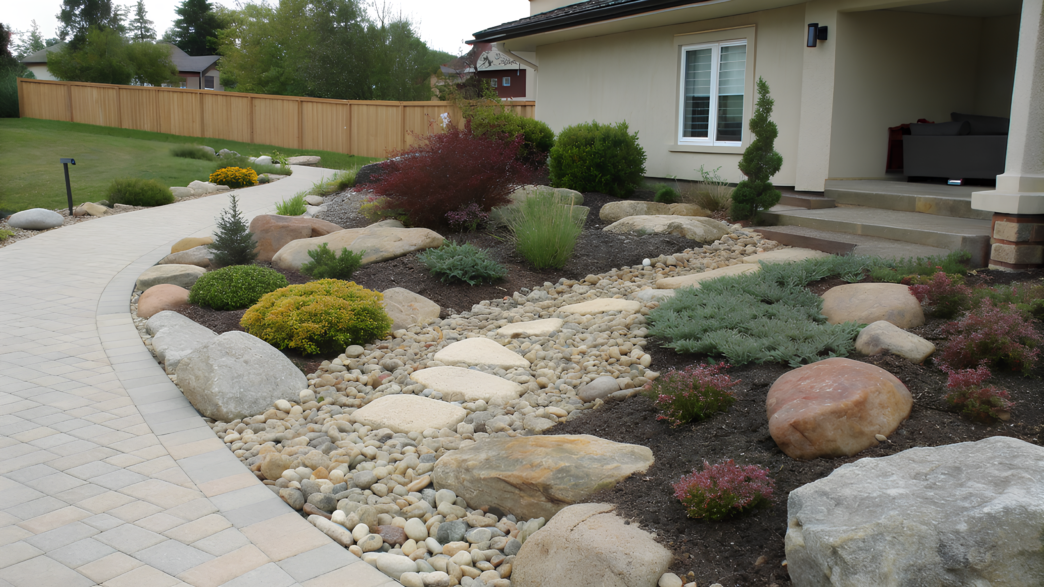For those who love a visually appealing and low-maintenance garden, a rock garden is the perfect solution. They look great in areas with poor soil or minimal rainfall. Rock gardens are like a piece of natural beauty in your yard. Here are 17 cheap rock garden designs for a low-maintenance yard that we hope you can implement into your yard.
1. Minimalist Zen Garden
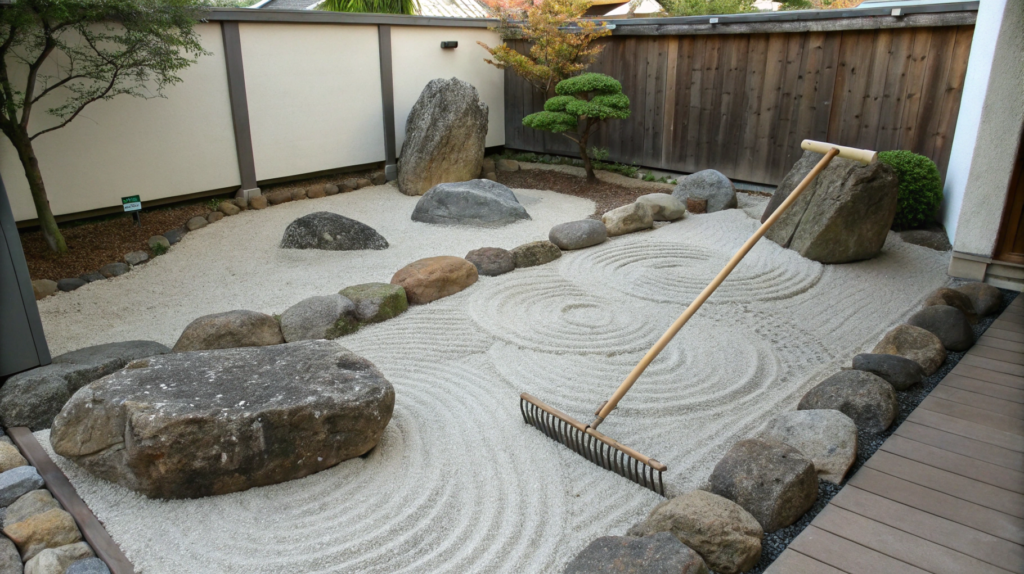
This design is suitable for small areas, a patio, or even a small corner of your garden. A minimalist Zen garden evokes the tranquility of a Japanese Zen garden, but on a small scale. The main goal of this design is to create a peaceful space that is visually calming and low-maintenance.
How to create
- Choose a small, flat area in your yard. Ideally, it will be a sunny spot that is protected from strong winds. Draw its borders with large stones or wooden beams.
- Lay a layer of weed control fabric on the ground to minimize garden maintenance. Pour a layer of fine gravel or sand about 5-7 cm thick on top of the fabric. Smooth it out.
- Using a rake with long teeth, make patterns on the sand or gravel. These can be circles around large stones (symbolizing water) or smooth wavy lines (symbolizing movement). The patterns should be simple, because their simplicity emphasizes minimalism.
- Place several large stones in the center or at the edges of the garden. They will serve as focal points. If space allows, include a small pond or fountain. To emphasize the atmosphere, you can include a small stone lantern or place a bonsai.
Care tips
Regularly rake the patterns and remove debris.
2. Rock Garden with Succulents
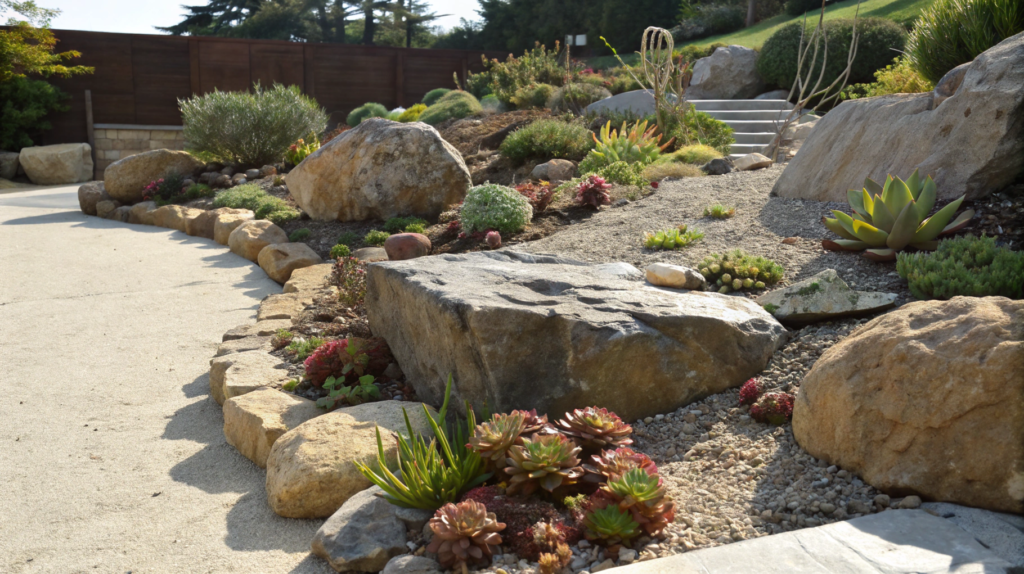
Succulents are known for their hardiness and unique aesthetics, and rocks complement their natural texture perfectly. This garden is suitable for sunny areas and for those gardeners who want to decorate their yard without unnecessary worries.
How to create
- Choose a sunny area. If there is grass or weeds in the chosen place, remove them along with the top layer of soil.
- Lay down a weed barrier to prevent their growth.
- Arrange rocks of different sizes, leaving gaps for planting. Start with large boulders. Position the rocks so that they do not block the plants from the sun. Then add medium-sized rocks and small gravel to fill the space. The distance between the rocks should be large enough for planting.
- Fill the gaps between the rocks with special soil for succulents. It should be well-drained to avoid stagnant water, which can damage the plants. If you are using regular soil, mix it with sand or perlite to improve drainage.
- Plant succulents such as echeveria, sedum and crassula in the prepared spaces. Make small holes in the soil, plant the plants and gently tamp the soil around the roots.
- After planting, spread a layer of small gravel or decorative stones around the plants. This will not only give the garden a neat and finished look, but will also help retain moisture in the soil. You can use gravel of different colors.
Care tips
Water the plants infrequently, only when the soil is completely dry.
3. Spiral Herb Rock Garden
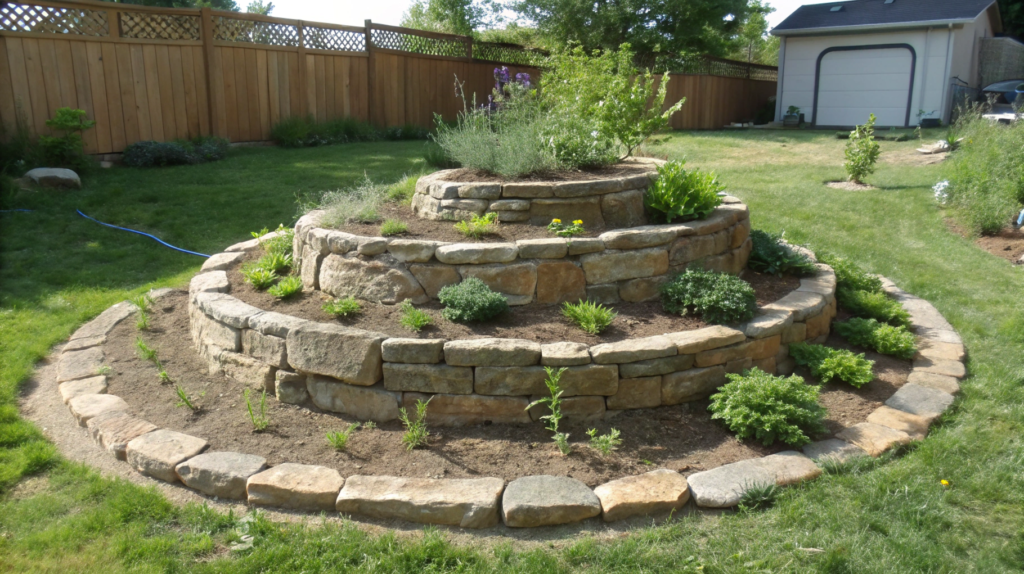
The Spiral Herb Rock Garden allows you to grow a variety of herbs in a small area. The spiral shape allows the top tier to be used for sun-loving plants, while the bottom tier retains more moisture and shade for more delicate crops.
How to create
- Find a sunny spot in your yard. Determine the size of the future spiral. For a small garden, a diameter of 1.5-2 meters is enough. Using a rope or hose, draw the outline of a circle on the ground. The center of the circle will be the beginning of the spiral.
- Start laying out the spiral from the center of the circle, using medium and large stones. Gradually move outward, increasing the height of the spiral as you go. The top tier should be about 50-80 cm higher than the bottom to create a difference in microclimates.
- Place the stones firmly on top of each other so that the structure is stable. Try not to make the spiral too narrow so that you have enough space to plant herbs. The optimum width between the turns of the spiral is about 30-50 cm.
- Fill the space between the stones with well-drained soil. To do this, mix regular garden soil with sand or compost in a ratio of 3:1. Firm the soil as you fill it to avoid subsidence in the future. The upper levels of the spiral may require lighter soil, as they dry out faster.
- Plant herbs. Place sun-loving herbs at the top (such as rosemary, lavender or sage), and shade-loving herbs (such as coriander, mint or lemon balm) at the bottom.
- Add small decorative stones in the spaces between the herbs for a neater look.
Care tips
Pick herbs regularly to stimulate their growth and prevent them from becoming crowded.
4. Rock Garden in the Form of a Dry Streambed
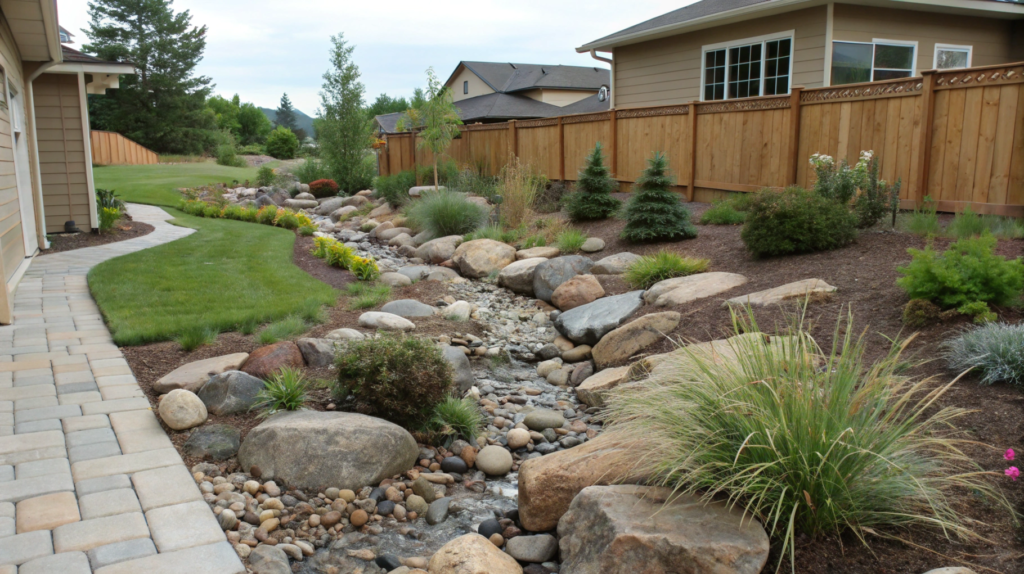
This design mimics the look of a natural riverbed, adding both dynamism and tranquility to your yard. In addition to its aesthetics, this structure effectively directs rainwater, preventing stagnation or soil erosion.
How to Create:
- Choose a Sloped Area. If you don’t have a natural slope, create an artificial incline.
- Prepare the Trench. Dig a shallow trench (approximately 10–20 cm deep) and line it with weed barrier fabric. The width can vary depending on the desired size of the “river.”
- Fill with Stones
- Use larger stones along the edges to form a visual boundary.
- Fill the center with smaller pebbles or river rocks to mimic the look of flowing water. For added texture, include some flat boulders.
- Plant Decorations. Add ornamental grasses (e.g., miscanthus), ferns, or ground-cover plants like sedums along the edges. This enhances the natural look of the composition.
Care tips
Regularly clean the “riverbed” by removing leaves, branches, and debris to maintain a neat appearance.Monitor the plants along the edges: remove weeds and trim overgrown shoots to keep the design tidy and balanced.
5. Raised Bed with Stones

A raised bed with stones adds height and volume to your yard. It serves as a great way to showcase vibrant plants and flowers.
How to create
- Use large stones to build a retaining wall in the desired shape and size of the bed. Make sure the stones are placed securely and stably.
- Fill the structure with a mix of garden soil and compost.
- Plant a variety of low-maintenance plants, such as sedums, drought-tolerant perennials, or ornamental grasses.
- Cover the exposed areas of soil with small stones or gravel. This helps retain moisture and gives the garden a neat appearance.
Care tips
Regularly check the stability of the retaining wall and remove weeds as necessary.
6. Rock Garden with Cacti
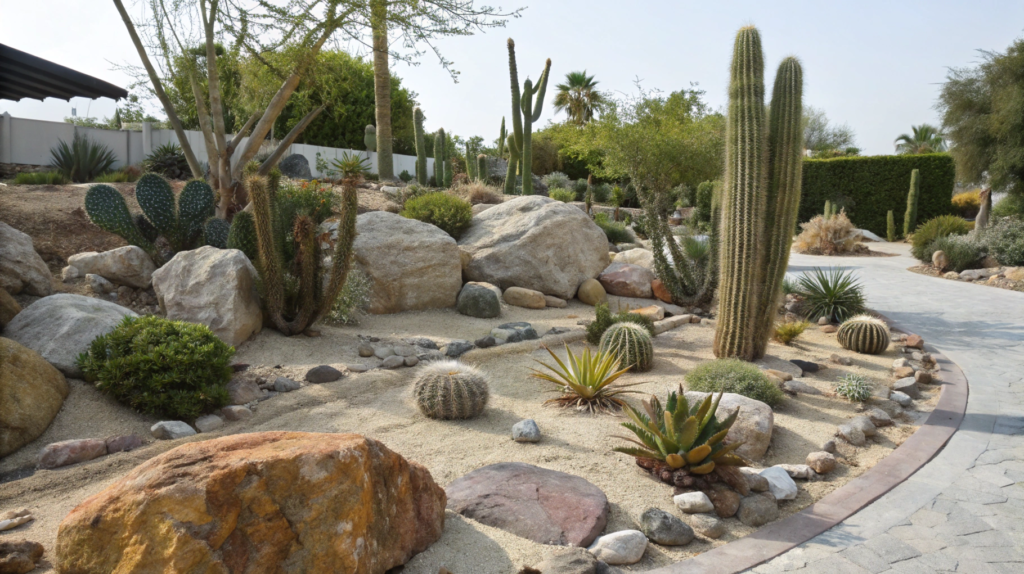
Cacti and rocks together create a dramatic desert look. This design will look great in hot climates. And by the way, it requires virtually no maintenance.
How to create
- Clear the area and lay down a weed-proof fabric.
- Spread a layer of coarse sand or gravel as a base.
- Place cacti of different shapes and sizes on the area, leaving enough space between them for growth.
- Place large rocks around the cacti to make it look visually interesting.
Care tips
Water the cacti very rarely and remember to use gloves when replanting them.
7. Rock Garden with Native Plants
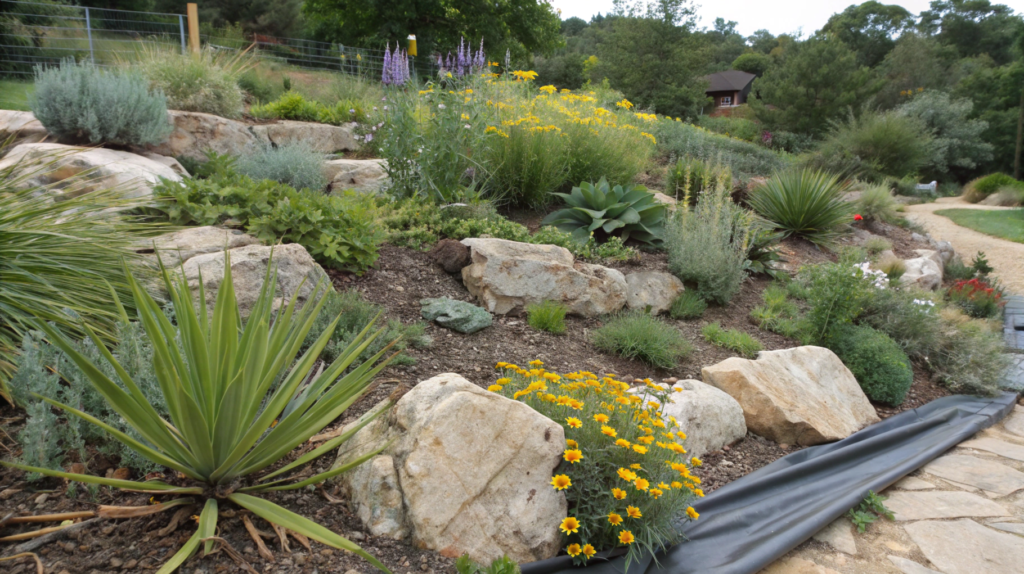
Native plants are usually already adapted to the existing climate, so you should use them in a rock garden. The plants will grow well without requiring much care.
How to create
- Do some research on what plants are suitable for your region. These can be yucca, salvia or rudbeckia.
- Clear the area and lay down weed control fabric.
- Arrange the rocks so that it looks natural, remembering to leave gaps between them for planting.
- After that, plant the selected species, providing them with suitable light and soil conditions.
Care tips
Water the plants only during dry periods and prune as needed.
8. Minimalist Rock Garden
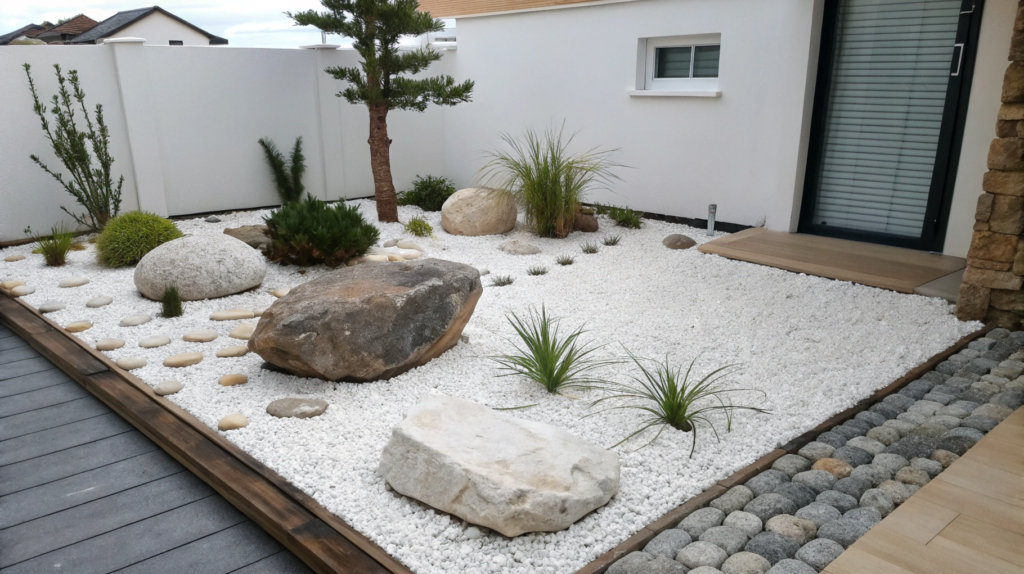
This design focuses on simplicity and cleanliness. It usually includes a minimal amount of plants and rocks, creating a modern and neat look. Those who prefer a simple aesthetic and low maintenance will definitely choose a minimalist rock garden.
How to create
- As always, start by choosing a small area and clearing it of weeds and grass.
- Lay down a layer of gravel or small white rocks to create a clean base.
- Place a few large rocks as focal points, maintaining symmetry or order.
- Add 1-2 low-maintenance plants, such as ornamental grasses or succulents, for emphasis.
Care tips
Clean the gravel regularly to remove debris and refresh the top layer of rocks as needed.
9. Rock Garden for Wildlife

This garden will not only decorate your property, but will also attract pollinators and other beneficial insects, benefiting the environment. It is a harmonious combination of nature and design.
How to create
- Use large stones and boulders to create a natural background.
- Plant flowering plants such as lavender, milkweed or chamomile. They will attract bees and butterflies.
- Install a small waterer or mini fountain to attract the attention of birds.
- Place a few branches or picturesque old driftwood around the area. They will create hiding places for insects.
Care tips
Avoid the use of pesticides and keep the water in the waterer clean.
10. Alpine Rock Garden
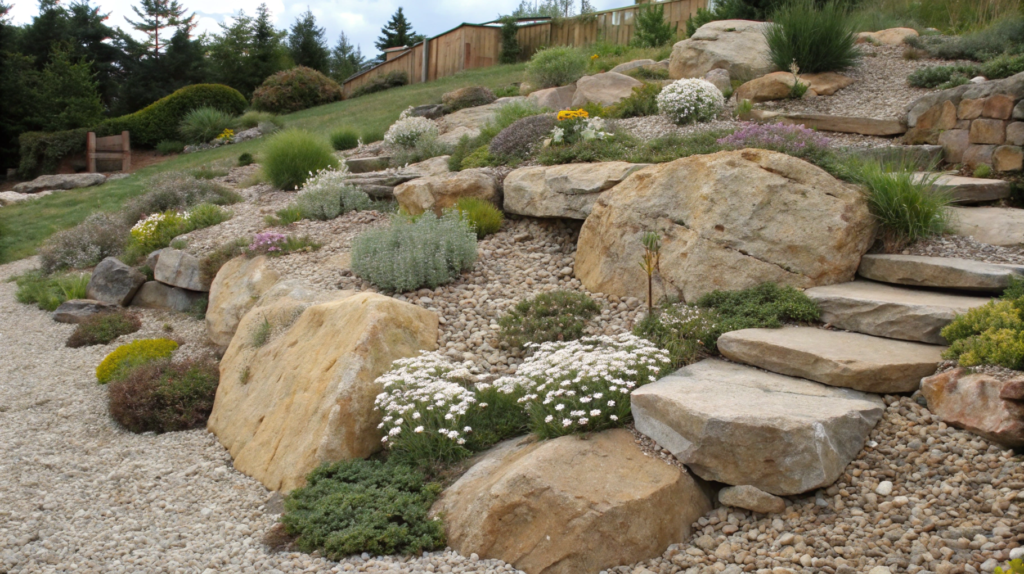
The Alpine rock garden design is inspired by mountain landscapes and showcases the beauty of alpine plants. It adds depth to your site.
How to create
- Create an artificial hill using a mixture of soil and gravel for good drainage.
- Place large stones and boulders to create “slopes” and “cliffs.”
- Plant alpine plants such as edelweiss, saxifrage or thyme. Use the cracks between the stones for planting.
- Add small gravel around the plants. This will emphasize their beauty.
Care tips
Water the plants moderately, avoid overwatering, and remove weeds in time.
11. Desert Rock Garden
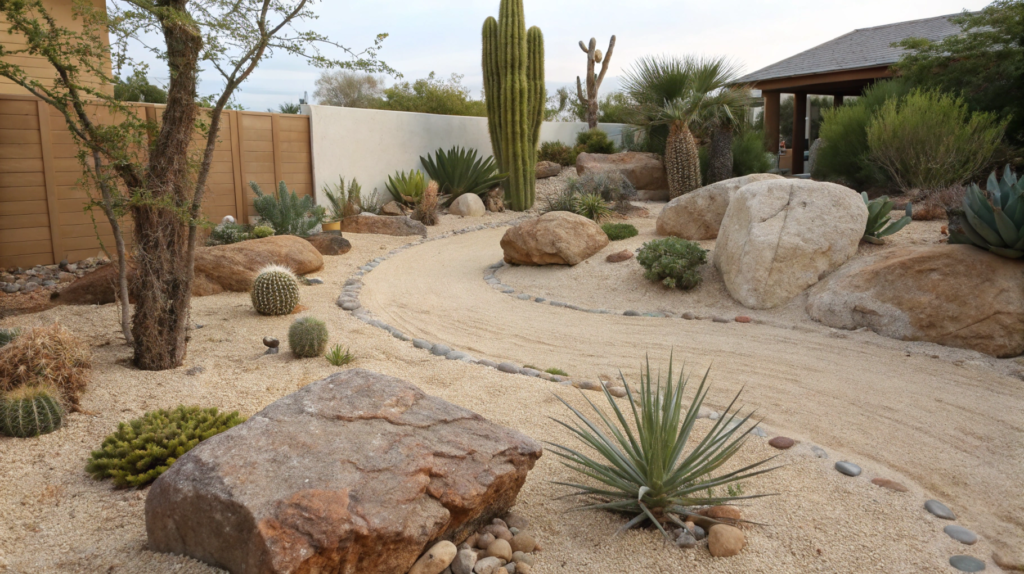
This rock garden style is suitable for warmer climates or for creating a unique and modern accent. Cacti, succulents and sandy soil will give the area an exotic look and will fit well into a desert rock garden.
How to create
- Clear the area and lay down a weed barrier to prevent unwanted plant growth.
- Cover the surface with sand or small gravel to create a texture reminiscent of a desert landscape.
- Place cacti and succulents such as aloe, agave and sedum in a loose arrangement.
- Add a few large rocks or boulders for visual interest.
Care tips
Water sparingly as these plants thrive in dry conditions. Use special tools to care for cacti to avoid injury from thorns.
12. Garden with colorful decorative stones

This design is suitable for those who want to add brightness to their site. Decorative colored stones create an unusual visual effect and decorate any corner of the garden, turning it into a lively and artistic space.
How to create
- Clear the chosen area from vegetation and level the surface to create a flat base.
- Use stones of different colors (for example, white, gray, red, blue or green) to create patterns, geometric shapes or winding paths. You can lay the stones in a mosaic style or use them to delimit individual areas.
- Add focal points by placing a few colorful elements, such as flowering plants in pots, sculptures, small fountains or decorative garden lanterns. This will definitely attract attention.
- Use small gravel to fill the gaps between the colored stones. This will add contrast and give a finished look.
- Install borders (e.g. metal or stone) to keep the stones in place and keep the garden looking neat.
Care tips
Rinse the stones regularly with water to keep them bright. And over time, renew or replace those that have lost their color. This will keep the garden bright and attractive for a long time.
13. Rockery Garden
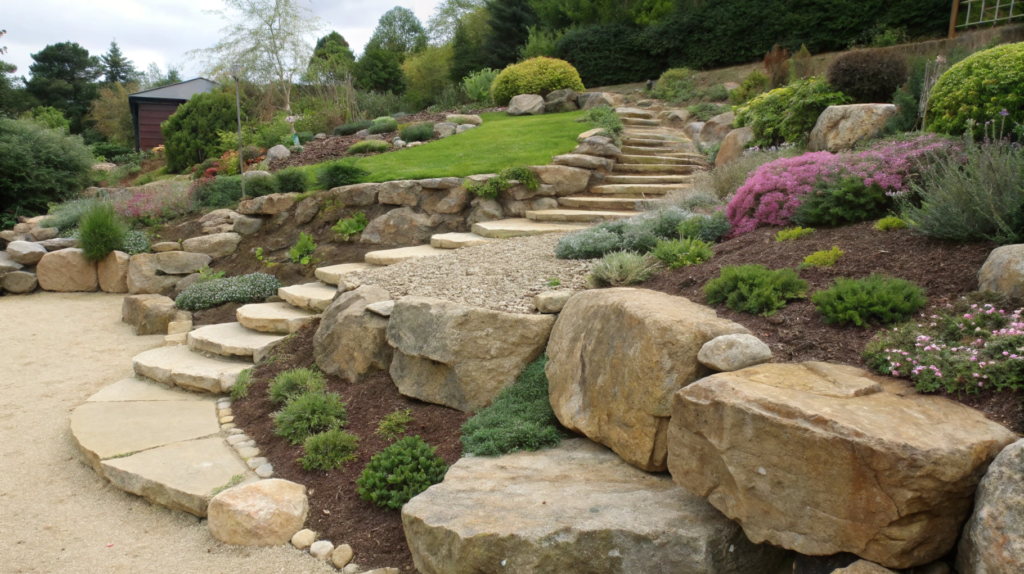
Rockery is a small corner of the garden where plants and stones are combined in a harmonious design. They fit perfectly into small areas or recreation areas. Rockery requires only minimal maintenance and looks attractive all year round.
How to create
- Find a place with a slight natural slope, or create one artificially to emphasize the relief of the composition.
- Use large stones, placing them in the form of steps, terraces or free groups. And to make the composition look more natural, use stones of different shapes and sizes.
- Place fertile soil with the addition of sand between the stones to improve drainage. This will provide good growing conditions for the plants.
- In empty areas, plant perennials such as sedum, moss, grass pink or thyme. You can also plant low-growing shrubs, such as dwarf varieties of juniper or barberry. Ground cover plants will also be useful, as they will make the composition look complete.
Care tips
Regularly trim the plants so that they do not hide the stones, and remove the weeds. Once a year, replant or renew individual plants to maintain their health and decorative appearance.
14. Rock garden with a fountain
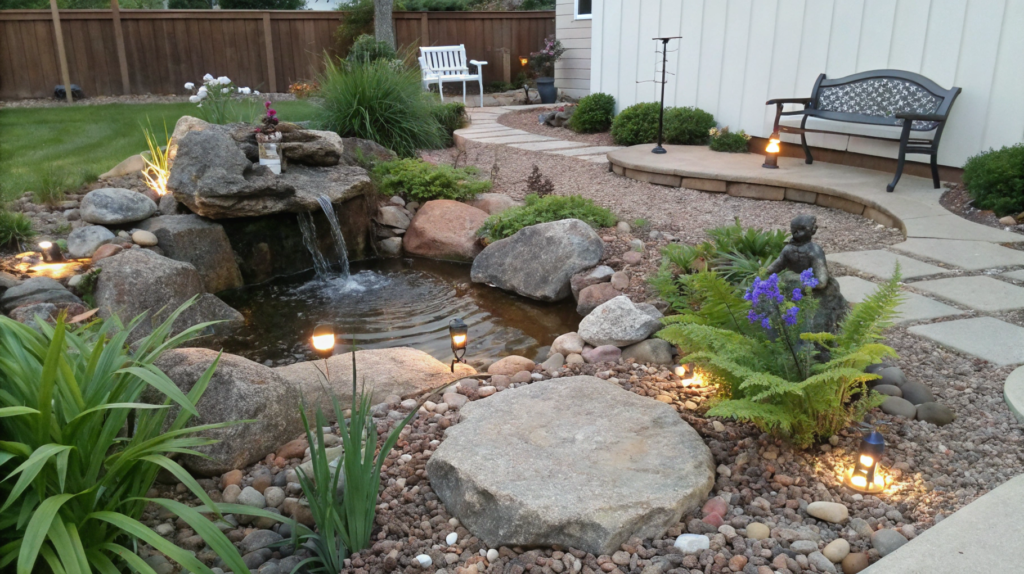
The combination of rocks and water creates a calming atmosphere. A small fountain surrounded by rocks will become a favorite place in your garden. This design is suitable for both spacious areas and small recreation areas.
How to create
- Choose a place with access to electricity to operate the fountain pump.
- Install a small fountain or waterfall using a ready-made kit or create one yourself, for example, from a large ceramic vessel or stone bowl.
- Place large rocks around the fountain and plant moisture-loving plants between them, such as ferns, irises, hostas or ornamental grasses.
- Fill open areas around the fountain with small gravel, river sand or pebbles. You can place decorative elements such as lighting, figurines or wooden bridges, it will create an atmospheric effect.
- Place a garden bench or chair nearby. Create a place for yourself to relax near the water
Care tips
Regularly clean the water and check the operation of the pump. Check out small outdoor water pumps for affordable options.
15. Garden with painted stones
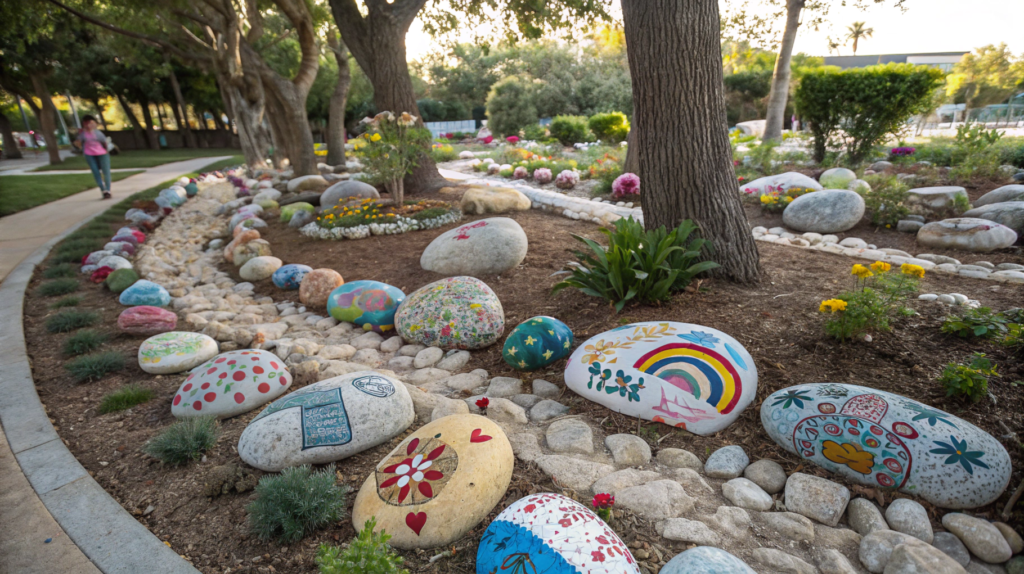
This design is perfect for creative people and families with children. Painted stones create a cheerful atmosphere and add personality to your site.
How to create
- Collect smooth medium-sized stones suitable for painting. It is best to use river or sea stones. Clean them from dirt and dust, dry.
- Use acrylic paints to create drawings, patterns, inscriptions – everything according to your desire and skill. After the paint dries, apply a protective layer of varnish to prolong the brightness of the drawings. Buy outdoor rock painting kits to make this project easy and fun for the whole family.
- Arrange the stones in the garden in a random composition: along paths, at the base of trees, around flower beds or next to a pond.
- Add small plants (sedums or succulents) or decorative gravel to unite the stones into a single design.
Care tips
Refresh the paint on the stones once a year to make them look bright. If necessary, clean the stones from dust and dirt with a damp cloth.
16. Stone Garden with Paths

This design helps to combine functionality and aesthetics. Decorative paths laid with stones make your site not only a beautiful, stylish element of the landscape, but also convenient for moving.
How to create
- Choose the direction of the path, for example, connect the main areas of the garden: the entrance, the sitting area and flower beds, and clear the area of vegetation.
- Lay geotextile or fabric to protect against weeds. This will make it easier to maintain the path and prevent grass from growing.
- Use large flat stones, such as sandstone, slate or granite, to create the surface of the path. Lay them with a small gap to maintain a natural look and ensure good drainage.
- Fill the gaps between the stones with small gravel or sand to fix them.
- Add low-growing plants along the path, such as sedum, or place pots with flowers, lanterns or garden figures. Consider solar powered garden lights, which are easy to install and require no electricity.
Care Tips
Sweep the path to remove leaves and debris, and periodically replace the gravel between the stones. If you use groundcover plants, trim them back to keep them from growing beyond the path.
17. Rock Garden with Lighting
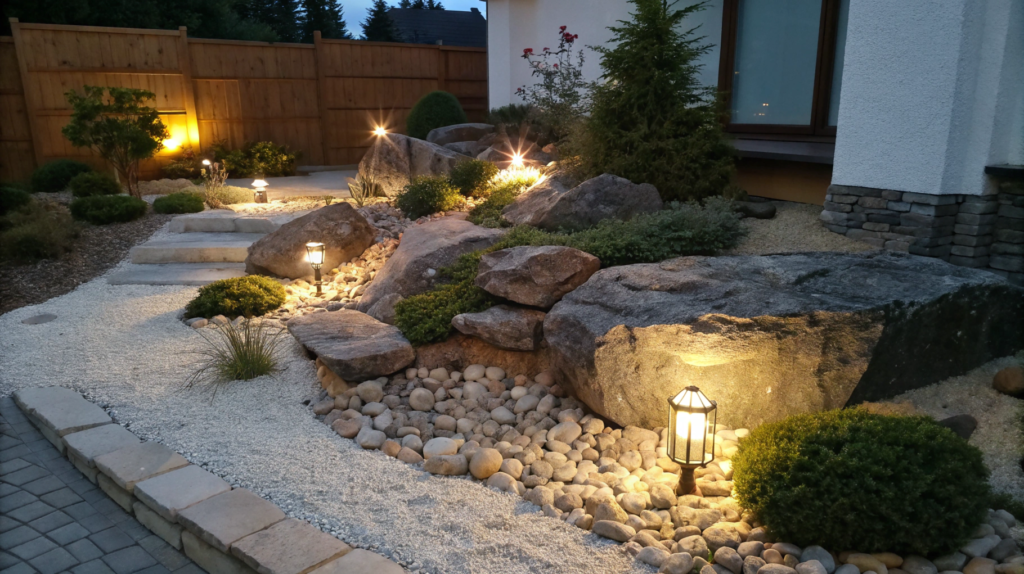
Lighting adds mystery to your rock garden and turns it into a spectacular place even at night. Skillfully placed lights emphasize the texture of the stones, the silhouettes of plants and create a cozy atmosphere.
How to create
- Clear the area and create a base of gravel or sand. Fill the base with a layer of gravel or sand to create a stable base.
- Lay out large stones and arrange them so that they become focal points of the garden. Arrange them in a free form or create a structured design, such as a circle or spiral. Dilute the composition with small stones for transitions and detailing.
- Install solar garden lights or use energy-saving lamps. Place them between the stones or under small decorative shrubs. For effect, use different levels of lighting: lower (illuminating the stones from below) and side.
- Add low-growing plants such as dwarf juniper or thyme that will not block the lights and will fit into the composition.
Care tips
Regularly check the lighting to ensure it is working properly, clean the lamps from dirt and dust.
Transform your garden into a unique and stylish space with these 17 cheap rock garden designs for a low-maintenance yard. Whatever your preference, these ideas will help you find inspiration and create a low-maintenance garden.
Which design did you like the most?

